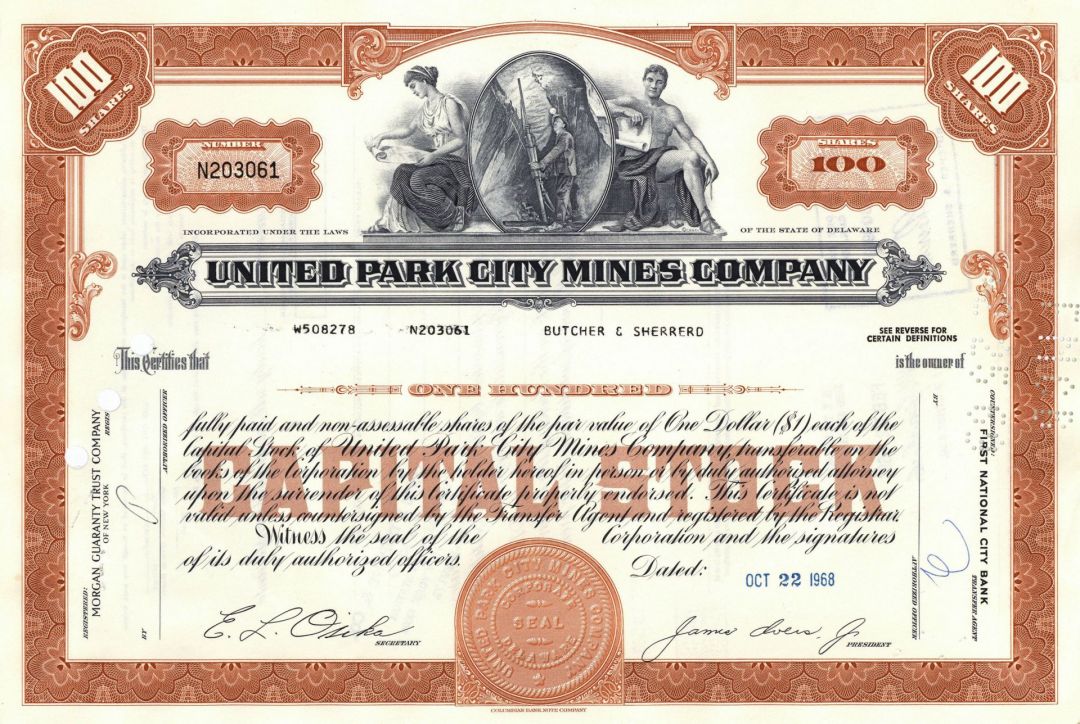United Park City Mines Co. - Utah Mining Stock Certificate - Very Historic
Inv# MS1060 StockUtah
Mining Stock. Male and female figures sitting at each side of oval scene of a miner at work. Scarce!!!
Park City is a city in Summit County, Utah, United States. It is considered to be part of the Wasatch Back. The city is 32 miles (51 km) southeast of downtown Salt Lake City and 20 miles (32 km) from Salt Lake City's east edge of Sugar House along Interstate 80. The population was 7,558 at the 2010 census. On average, the tourist population greatly exceeds the number of permanent residents.
After a population decline following the shutdown of the area's mining industry, the city rebounded during the 1980s and 1990s through an expansion of its tourism business. The city currently brings in a yearly average of $529.8 million to the Utah Economy as a tourist hot spot, $80 million of which is attributed to the Sundance Film Festival. The city has two major ski resorts: Deer Valley Resort and Park City Mountain Resort. Both ski resorts were the major locations for ski and snowboarding events at the 2002 Winter Olympics. Although they receive less snow and have a shorter ski season than do their counterparts in Salt Lake County, such as Snowbird resort, they are much easier to access.
The area was traveled by the early Mormon pioneers on their journey to where they settled and built Salt Lake City. One of their leaders, Parley P. Pratt, explored the canyon in 1848. He was given a charter the following year to build a toll road through it, which was finished in 1849. The basin at the top of the canyon was an ideal place to graze, and a few families settled. Early on, the area was deeded to Samuel Snyder, Heber C. Kimball and Jedediah Grant. The settlers named it "Parley's Park City", which was shortened to "Park City" in the early 1900s. The first known discovery of ore in this area was by Colonel Patrick E. Connor, who instigated his men to search the area in bringing non-Mormons to the Utah region. The finding of silver, gold and lead sparked the first silver mines in Park City in the 1860s. Park City's large mining boom brought large crowds of prospectors setting up camps around the mountain terrain, marking the first mining settlements. Although it was not the first find, the Ontario silver mine, discovered by Herman Buden in 1872 and later purchased by George Hearst, was the first major producer.
Another prominent mining family was that of William Montague Ferry Jr. Ferry Moved to Utah from West Michigan already a very wealthy man. He had previously been a Colonel in the Union Army, mayor of Grand Rapids, and was son of wealthy businessman William Montague Ferry. Ferry was followed by a group of other wealthy Michiganders who came to be the social elites of the town. Ferry owned numerous mines and donated the land for Westminster College. Ferry also unsuccessfully ran for governor of Utah. Ferry was also the Uncle of Salt Lake City Mayor W. Mont Ferry.
In 1880, a spur line was established to the Echo station of the First Transcontinental Railroad. By 1892 the Silver King Mine and its owners Thomas Kearns and David Keith took the spotlight as one of the most famous silver mines in the world. While silver mines were doing well in Utah, other mines around the world were not doing as good, which drew many of these miners to Park City. The town flourished with crowds of miners and wealth, but by the 1950s, the town nearly became a ghost town. This was due in part to a drop in the price of silver.
The transformation of the town into a ski resort is primarily attributed to the silver need during and after World War I, as that and the Great Depression hurt the economy. Once the site of the largest silver-mining camp in the country, the town was nearly destroyed by fire in 1898. Another accident occurred in 1902 when 34 miners were killed in an explosion in the Day West Mine. The mining community never fully recovered and so the town turned to skiing. The silver industry was suffering when 'Parkite' miners presented to Utahns Inc. a proposal for a ski resort called Treasure Mountain. This ski resort opened in 1963 on 10,000 acres (40 km2) of land the miners owned with mineral rights. This is said to be when tourists first largely began to visit Park City. This marks the beginning of the ski industry largely promoted by the Utah State Legislation as a destination resort.
As recently as the 1920s, miners in Park City were using underground trains and shafts to gain access to the mountain for skiing. Aerial trams once used for hauling ore were converted into chairlifts. To this day, there are still more than 1,000 miles (1,600 km) of old silver-mine workings and tunnels beneath the slopes at Park City Mountain Resort and neighboring Deer Valley. On Main Street, 64 Victorian buildings are listed in the National Register of Historic Places. There are many remaining mine buildings, mine shafts (most blocked off from outsiders with large steel doors), and hoists, including the weathered remains of the California-Comstock and Silver King Mines and the water towers once used to hydrate one of the biggest mines, the Silver King, provide some history of this mining town transformed into a skiing resort.
A stock certificate is issued by businesses, usually companies. A stock is part of the permanent finance of a business. Normally, they are never repaid, and the investor can recover his/her money only by selling to another investor. Most stocks, or also called shares, earn dividends, at the business's discretion, depending on how well it has traded. A stockholder or shareholder is a part-owner of the business that issued the stock certificates.










Ebay ID: labarre_galleries